

Paris, ville comestible? Un peu partout dans le monde, on assiste à un mouvement massif vers l’agriculture urbaine : jardins sur les toits, jardins partagés, fermes urbaines ou verticales.

Mais que représente donc aujourd’hui cette forme d’agriculture pour une ville comme Paris? On vous emmène faire le tour de quelques projets marquants. Près de 60 % de l’Humanité se concentre aujourd’hui dans les zones urbaines. D’ici 2050, cette proportion devrait atteindre 80 %, et la planète aura gagné 3 milliards d’habitants. Could Washington, D.C., Become the American Capital of Urban Farming? From the White House to the Washington Memorial, it's the famed symbols of American governments past and present that define Washington, D.C.
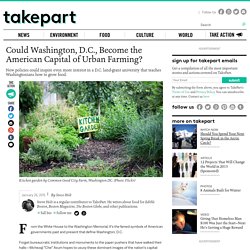
Forget bureaucratic institutions and monuments to the paper pushers that have walked their halls—Mchezaji "Che" Axum hopes to usurp these dominant images of the nation's capital: He wants urban farms to come to mind when people think of the District of Columbia. The third-generation Washingtonian envisions the district’s fast-growing urban core dotted with small plots that, together, would be capable of feeding its roughly 700,000 residents fresh, healthy fruits and vegetables. “We’re still in the beginning stages of this food revolution,” says Axum, who leads the Center for Urban Agriculture and Gardening Education at the University of the District of Columbia, one of the country’s only urban land-grant universities.
"A thousand people a month are moving into Washington, D.C. Urban Farming sur Pinterest. Agriculture urbaine : marais de Bourges et d'Amiens. La côte Est des États-Unis. These modular, hydroponic micro-farms highlight the future of high-tech urban ag. Cityblooms' urban agriculture solution is a high-tech approach to hyperlocal sustainable produce.

They call it "The Internet of Farms™" In urban areas, where space is at a premium, local food production takes quite a different shape than in the suburbs or country, where large lots and open spaces are the norm. For urban agriculture, growing space is where you find it, which might be a vacant lot in one instance, or a rooftop in another, or perhaps in an old factory or inside a shipping container. For those who don't own their own space, or whose growing space is made up of a bunch of smaller spaces, or if all that there's room for is a rooftop garden (but not enough room for an entire rooftop farm or a green roof), then one possible solution might be to use something like this modular growing solution, from Cityblooms.
Find out more about what Cityblooms is up to at their website. Graines de Vie présenté par IntelligenceVerte. Présentation détaillée du projet Nous lançons un mouvement citoyen pour la sauvegarde des variétés potagères et fruitières menacées de disparition et nous nous réapproprions les bases de notre souveraineté alimentaire pour une nourriture saine et responsable.
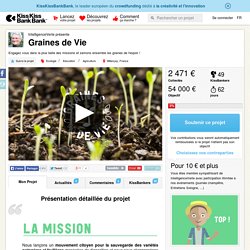
Les anciens consommaient plus de 3.000 espèces végétales comestibles. Jardins participatifs. Photo : Madeline Florance Il est temps de préparer vos bombes de graines (seedbombs) pour semer des graines de fleurs partout.
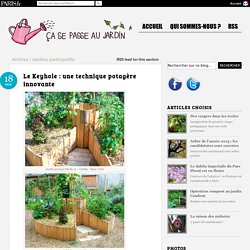
Les bombes de graines traditionnelles se font avec de l’argile, mais comme on n’a pas souvent de l’argile chez soi, je vous propose de le faire avec de coquilles d’œufs comme contenants. Des vergers dans les écoles. Mirabelles – julia_HalleFotoFan / Flickr CC Fleur de pommier – Cédric Fayemendy / Flickr CC Poirier – Guillaume Paumier / Flickr CC Fleurs de poirier – Angela Llop / Flickr CC.
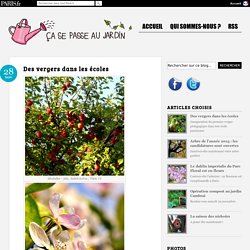
Jardinage de janvier. (5) Épinglé par COSI Blog sur Developpement durable. Agriculture urbaine et esthétisme. L’info du jour est une traduction en français de l’article : A DIY vertical garden « Milkwood: permaculture farming and living, trouvé sur le site milkwood.net.
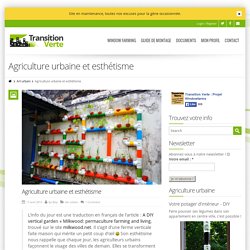
Il s’agit d’une ferme verticale faite maison qui mérite un petit coup d’œil Son esthétisme nous rappelle que chaque jour, les agriculteurs urbains façonnent le visage des villes de demain. Elles se transforment progressivement et nous devons nous attendre à de jolies surprises Pas de place pour faire pousser vos légumes ? Et bien le potager vertical pourrait devenir une sérieuse option dès aujourd’hui ! Certains sont grands, et d’autres petits, certains se fondent dans le décor et d’autres s’exposent. Voici un petit projet fait maison très funky mis en place par l’équipe de Calanthe Artisan Loft, au sein de leurs locaux à Melaka en Malaisie… Joe Ng Kim Chew avec son potager vertical chez Calanthe Artisan Loft Imaginez si plus de pans de murs étaient recouverts de système de culture comme celui-ci…
Archtober. Building of the Day #19 Franklin D.
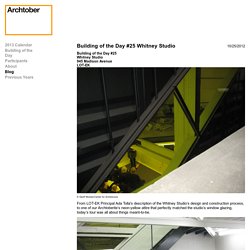
Roosevelt Four Freedoms Park Roosevelt Island Louis Kahn A moment of silence, please. Silence in the garden. Spark: Home Farm. The question of how to support and accommodate a rapidly ageing population confronts many nations in Asia.

With the Home Farm concept Spark’s aim is to generate discussion about the many potentials that can emerge from the mixing of two typically separate realms. The concept taps into the political and social zeitgeist of Singapore with a bold vision for sustainable city development and a powerful social message. Spark, Home Farm concept. Urban Farming sur Pinterest. Self-Cleaning Fish Tank Garden by Back To The Roots. Already an internet hit with their mushroom-growing kit, Back To The Roots went from fungi to fish.
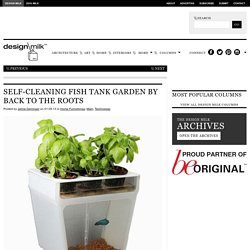
Raising over double their Kickstarter goal, they just launched this Home Aquaponics Self-Cleaning Fish Tank. “Jellyfish Barge” Provides Sustainable Source of Food and Water. The New Underground: Subway Stations Reimagined. In a campaign pledge last week that resembles a high school candidate’s promise to give out free pop during lunchtime, Paris mayoral candidate Nathalie Kosciusko-Morizet, of the center-right UMP party, floated the idea of reworking the abandoned “ghost stations” on the Paris metro. Photos released by her campaign, created by architects Manal Rachdi and Nicolas Laisné, show unused stops reimagined as public hotspots boasting amenities such as a swimming pool, theatre and concert hall, nightclub, art gallery and restaurant.
While the move hasn’t made waves with the voting public, we love the idea. Here’s a selection of other plans, proposals and projects that reconceptualize what can be done underground. Arsenal Subway Stop -- Paris Here’s Manal Rachdi and Nicolas Laisné proposal to turn the underground station at Arsenal, near Versailles, into a garden. Solar powered aquaponics for apartments. Lettuce Evolve offers aquaponic planters for gardening in small spaces. A container garden is a great way to grow your own food in a small space, and there are many creative ways you can go about creating them. A Dallas-based company, Lettuce Evolve, has created a system that can be used as a modular container garden or for aquaponic growing. GartenCoop, une ferme solidaire, autogérée par les agriculteurs et les consommateurs. Comment rapprocher agriculteurs et consommateurs ? Dans la région de Fribourg (Allemagne), la coopérative GartenCoop invente un nouveau mode de production : 290 associés sont responsables d’une ferme de neuf hectares, dont ils se partagent chaque semaine la récolte, nourrissant 600 personnes.
Solidaires les uns des autres, ils supportent les coûts et les risques de ce projet agricole écologique basé sur une philosophie résolument autogestionnaire. Bulbo cynara and quadra LED lights encourage plant growth in homes. Sep 08, 2014. Quand les Idéelles rencontrent les Ekovores. Au cœur de la réhabilitation de Malakoff, six jeunes femmes décident de se mettre en action pour faire naître des projets au sein de leur quartier.
Les immeubles poussent, les projets s’enchainent. Dans cette ferveur immobilière, Les Idéelles, association de six mères de famille actives, marquent la pause. Tout va très vite, leur quartier change, cela fait 10 ans en moyenne qu’elles y habitent et elles partagent l’impression de ne pas en être. « Nous avons envie de retrouver notre quartier ». Elles échangent régulièrement sur le devenir de leur quartier, tout en évoquant son passé et ne se sentent plus vraiment impliquées dans tous les changements qui s’opèrent, jour après jour, au pied de leurs « bananes », comprenez leurs immeubles. Bacsac Portable Gardens: Who Says You Can't Take It With You?
All images credit Bacsac Living a more mobile style of life has its drawbacks, including the inability to maintain a garden. Enter designer Godefroy de Virieu and landscapers Virgile Desurmont and Louis de Fleurieu, who "looked for an alternative solution to get round the constraints of the creation of a roof garden in town: difficulties of transportation, excessive weight, but also lack of choice of containers, most of which are often very expensive.
" So they invented the Bacsac, sturdy bags made from geotextiles that let the soil breathe, and the water drain. Erez & Guy Galonska. Let’s start with the basics: who are you, where are we, what are we doing here? Erez: We are Guy and Erez Galonska, brothers, sitting in Infarm, our urban indoor farm in Berlin-Kreuzberg. And how did you get here? Erez: We took a flight from Tel Aviv in December 2012 and arrived officially in Berlin to start this project. Before that I used to live here. (pauses) It’s quite a long story. Au Sial, la tendance après le fait-maison est au produit chez soi. Cueillir sa salade à sa fenêtre, manger l’oeuf de sa poule, faire pousser ses champignons et demain avoir une ruche domestique, la mode est à l’auto-production et les industriels tentent, tant bien que mal, de suivre le mouvement. Faire son marché dans le potager d'un inconnu. Partager une serre crowdsourcée.
Confier son potager à une appli. Vertical Farms Aren't Going to Solve Our Food Problems. Vertical (Diagonal?) Farm from Work AC in NYC TreeHugger has been dining on vertical farms since Mike first wrote about them back in 2005. We have not been entirely uncritical of them, even calling them Pie in the Sky. Stan Cox and David Van Tassel go a lot further in an article published in Alternet.
Sleek hydroponic unit lets you grow a garden in your kitchen. © Nano Garden. Compact Window Hydroponic Gardening System Fits Tight Urban Spaces. © Philip Houiellebecq Rising food prices and a yearning for a bit of homegrown green may be some of the reasons why city dwellers turn to gardening. But for those who lack land to actually grow food on, do-it-yourself ideas like windowfarming can be a revelation -- especially when all you have is some window sill space.
Aimed at those who are looking to try out windowfarming, but are reluctant about spending hours building their own system, British product designer Philip Houiellebecq's conceptual hydroponic growing system Auxano offers the ease of similar DIY windowfarms -- and without relying on electricity and the guesswork involved with other systems we've featured previously like Urbio. Made of recycled HDPE, steel and rubber, Auxano is designed as a slim, nested unit that can come apart easily, and can be arranged either vertically or horizontally. Plants and their roots are inserted into the removable top, which allows for easier harvesting. . © Philip Houiellebecq. Incroyables Comestibles Region Nazairienne. Cultiver des légumes dans une feuille de papier. Agriculture urbaine: une start-up berlinoise fait pousser des tomates à l'aide de poissons. ALIMENTATION - Les poissons sont en bas, qui font de l'engrais, les plantations sont en haut, qui font des tomates: bienvenue à la "ferme-container", prototype d'une agriculture urbaine qui allie pisciculture et cultures maraîchères, et cœur de métier d'une start-up berlinoise.
Dans la cour pavée d'une ancienne brasserie de la capitale allemande se dresse la mini-ferme de la société ECF: un container qui abrite l'élevage de poissons, coiffé d'une serre où poussent tomates, blettes et poivrons. Le principe est simple: des bactéries transforment l'ammonium des déjections des poissons en nitrates, qui servent d'engrais pour les cultures un étage au-dessus.